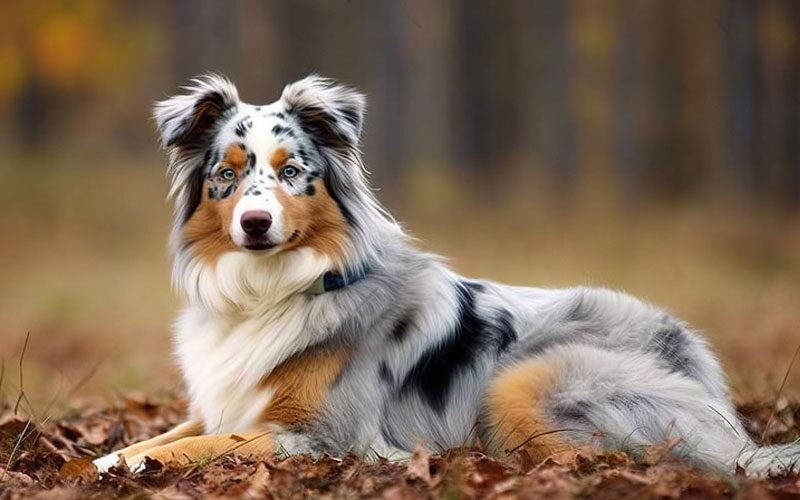
Category |
Details |
Origin |
United States (despite the name “Australian” Shepherd) |
Size |
Medium |
Weight |
Males: 50-65 lbs (23-29 kg), Females: 40-55 lbs (18-25 kg) |
Height |
Males: 20-23 inches (51-58 cm), Females: 18-21 inches (46-53 cm) |
Lifespan |
12-15 years |
Coat |
Medium length, double coat, straight or wavy |
Colors |
Blue merle, black, red merle, red – all with or without white markings and/or tan points |
Temperament |
Intelligent, active, friendly, protective, good-natured |
Nutrition |
High-quality dog food appropriate for the dog’s age (puppy, adult, senior) |
Exercise Needs |
High; requires daily vigorous exercise and mental stimulation |
Grooming Needs |
Moderate: regular brushing, occasional baths, and attention to ears and nails |
Good with Children |
Yes; generally good with children if properly socialized |
Good with Pets |
Yes, can get along with other pets if properly socialized |
Health Concerns |
Hip dysplasia, elbow dysplasia, epilepsy, cataracts, certain cancers, and progressive retinal atrophy (PRA) |
Living Environment |
Adaptable to various living environments but prefers space to run and play; best suited for homes with a yard |
Original Purpose |
Herding livestock |
Socialization |
Requires early and ongoing socialization to be well-mannered |
Barking Level |
Moderate; can be vocal, especially when working or alerting |
Independence |
Moderate; enjoys companionship and being part of family activities |
Playfulness |
High; enjoys playtime and interactive activities |
Sensitivity Level |
High; can be sensitive to harsh treatment or neglect |
Weather Tolerance |
Good tolerance for cold and moderate heat; shelter needed in extreme temperatures |
The Australian Shepherd, sometimes called the Aussie, is a fascinating and adaptable breed praised for its intellect, unique looks, and limitless activity. Aussies are well-known for their herding skills and have developed into cherished family companions who thrive in various canine sports and activities.
The following article explores the Australian Shepherd’s origins, personality, and care requirements. So, let’s get right into our article without wasting any time.
Origin
Despite its name, the Australian Shepherd originated in the United States in the nineteenth century. The breed’s deceptive name most likely originates from ties with Basque shepherds who brought their merle-patterned dogs with them when they immigrated to America from Australia.
Prized for their versatility and herding abilities, these canines played a crucial role in honing the Aussie. Ranchers in the American West valued the Australian Shepherd for its intelligence, agility, and work ethic, which helped shape the breed into what it is today—a versatile and active dog.
Personality and Looks

The Australian Shepherd is well-known for its eye-catching appearance and lively disposition. Aussies are bright, devoted, and energetic large dogs breed who love exercise and mental challenges. They make excellent working dogs and wonderful companions for busy families.
They have a unique double coat that can be straight or wavy, a medium-sized, balanced build, and various colors, including red, black, blue, and red merles. Their distinct attractiveness is enhanced by their expressive eyes, which can be brown, blue, amber, or a mix of these colors, as well as their attentive and watchful manner.
Nutrition
Australian Shepherds thrive on a balanced diet rich in high-quality proteins, fats, and carbohydrates. Opt for dog food that lists meat as the primary ingredient and includes healthy fats like omega-3 and omega-6 for coat health. Avoid fillers like corn and soy. Portion control is crucial to prevent obesity, especially since Australian Shepherds are active dogs that need the right amount of calories to sustain their energy levels without gaining excess weight.
Health Issues
Australian Shepherds are generally healthy but can be prone to certain genetic health issues. Common concerns include hip dysplasia, which can lead to arthritis and eye conditions such as cataracts and progressive retinal atrophy (PRA). Epilepsy is another issue seen in the breed. Regular veterinary check-ups, a nutritious diet, and maintaining a healthy weight through exercise can help manage and prevent some of these health problems.
Pros and Cons of Australian Shepherd Dog
Pros | Cons |
Active & Energetic: Families or individuals who prefer outdoor activities will find them the ideal companions due to their high energy levels. | Separation Anxiety: They emotionally build strong bonds with their owners, which can cause separation anxiety and potentially destructive behavior if they are left alone for long periods of time. |
Trainability: They are pretty trainable because of their intelligence and drive to please, and they frequently do well in competitive and advanced training. | Shedding: To control shedding and avoid matting, frequent grooming is necessary for this year-round shedding of their double coat. |
Good with Kids and Pets: Australian Shepherds are excellent family dogs when properly socialized and become well-mannered around children and other animals. | Not Suitable for Apartment Living: Australian Shepherds don't do well in compact spaces like flats because of their size, energy, and desire for room to run around. |
How To Take Care
Taking care of an Australian Shepherd involves tackling its physical, mental, and emotional requirements. Regular exercise is essential; kids need one to two hours a day of intense activity, such as running, walking, or playing in a safe place. Give them puzzle toys, interactive games, and training sessions since mental stimulation is just as vital.
Regular grooming is necessary to control shedding and avoid matting in their double coat. A caring home, lots of care, and regular training will keep your Aussie happy and healthy.
Wrapping Up
The Australian Shepherd is a magnificent breed recognized for its intellect, drive, and devotion. It is a devoted and enthusiastic worker who excels in agility and herding and is a wonderful family friend. To ensure a happy, healthy, and well-mannered dog, new owners must be ready to provide for the breed’s high exercise and mental stimulation requirements.







